Saturday, November 30, 2013
On St. Andrew's Day.
A Connery adventure in Kuala Lumpur—

For another Kuala Lumpur adventure, see today's update
to "In Defense of Plato's Realism"—

The July 5, 2007, post linked to
"Plato, Pegasus, and the Evening Star."
For related drama from Kuala Lumpur, see
"Occam's Razor, Plato's Beard."
Comments Off on For Sean Connery
Continued from October 30 (Devil’s Night), 2013.
“In a sense, we would see that change
arises from the structure of the object.”
— Theoretical physicist quoted in a
Simons Foundation article of Sept. 17, 2013
This suggests a review of mathematics and the
“Classic of Change ,” the I Ching .
The physicist quoted above was discussing a rather
complicated object. His words apply to a much simpler
object, an embodiment of the eight trigrams underlying
the I Ching as the corners of a cube.

See also…
(Click for clearer image.)

The Cullinane image above illustrates the seven points of
the Fano plane as seven of the eight I Ching trigrams and as
seven natural ways of slicing the cube.
For a different approach to the mathematics of cube slices,
related to Gauss’s composition law for binary quadratic forms,
see the Bhargava cube in a post of April 9, 2012.
Comments Off on Waiting for Ogdoad
Friday, November 29, 2013
"These are odd facts…." — G. H. Hardy,
quoted in the previous post, "Centered"
Other odd facts:
If n is odd, then the object at the center
of the n×n square is a square.
Similarly for the n×n×n cube.
Related meditation:
“In a sense, we would see that change
arises from the structure of the object,” he said.
“But it’s not from the object changing.
The object is basically timeless.”
— Theoretical physicist quoted in a
Simons Foundation article of Sept. 17, 2013,
"A Jewel at the Heart of Quantum Physics"
See also "My God, it's full of… everything."
Comments Off on Odd Facts
"I have now come to the most difficult part of my story."
— George MacDonald
"265" — Page number and centered square number
"153" — Triangular number (as noted by St. Augustine)
"265/153" — Object Lesson
An accurate description of such number lore:
"These are odd facts, very suitable for puzzle columns
and likely to amuse amateurs, but there is nothing
in them which appeals much to a mathematician.
The proofs are neither difficult nor interesting—
merely a little tiresome. The theorems are not serious;
and it is plain that one reason (though perhaps not the
most important) is the extreme speciality of both the
enunciations and the proofs, which are not capable of
any significant generalization." — G. H. Hardy
See also some remarks on figurate numbers in this journal.
|
Nothing went wrong at the back of the north wind.
Neither was anything quite right, he thought.
Only everything was going to be right some day….
"What a queer place it must be!"
"It's a very good place."
"Do you want to go back again?"
"No; I don't think I have left it; I feel it here, somewhere."
"Did the people there look pleased?"
"Yes— quite pleased, only a little sad."
"Then they didn't look glad?"
"They looked as if they were waiting to be gladder some day."
— George MacDonald
|
Comments Off on Centered
For the birth date of C. S. Lewis and Madeleine L'Engle.
|
THE GOLD KEY
The speaker in this case
is a middle-aged witch, me —
tangled on my two great arms,
my face in a book
and my mouth wide,
ready to tell you a story or two.
— Anne Sexton
|
"Now he believed that where there was a key, there must also be a lock…."
— The Brothers Grimm
|
"We must find the country from which the shadows come," said Mossy.
"We must, dear Mossy," responded Tangle. "What if your golden key should be the key to it?"
"Ah! that would be grand," returned Mossy.
— George MacDonald
|
Comments Off on Tale
Thursday, November 28, 2013
From the cover of Anne Sexton's Transformations—
"Her metaphoric strength has never been greater —
really funny, among other things, a dark, dark laughter."
— C. K. Williams
Another dark lady:

See also Karr in this journal on the date of the above article—
May 24, 2012, the feast of the dark lady.
Comments Off on Dark Ladies
From "Why Was New Haven Divided into Nine Squares?"
"Of note on the Wadsworth Map of 1748 are…
the Grammar School, the 'Goal' or jail…."
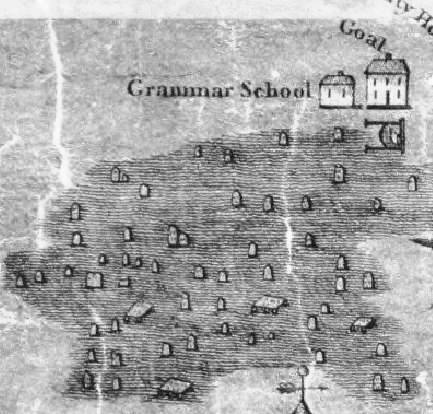
Related material: Puritan in this journal.
Non-Puritans may prefer the following image—

Source: Yale English Department banner
Comments Off on Goal
Continued from Deo Gratias , a post at noon last Saturday
that featured blues singer R. L. Burnside.
"It is a fresh spiritual that he defines"
— "An Ordinary Evening in New Haven"

Comments Off on Thanksgiving
Wednesday, November 27, 2013
A Yale death between Saturday night and Sunday morning—
|
See is not believed to have committed suicide, according to
the New Haven Independent. At this time the professor's death
remains under investigation.
Judicial Department spokeswoman Rhonda Hebert
told the Independent:
Mr. Samuel See was delivered to the
detention center on Nov. 23 at approximately
9:10 p.m. by New Haven Police and was alert
and communicating with Judicial Marshals
throughout his detainment until Marshals
assigned to the detention center found him
non-responsive in his cell at approximately
6 a.m. on Nov. 24.
— Huffington Post, 5:40 PM EST today
|
Comments Off on The Professor’s Death
Also known as Virgil the Geometer.
" Art, in other words, can speak to social conflicts,
and not always how you might think. Yvonne Scott,
a professor here at Trinity College, remarked
before the wake that in 1972 the invention of
Patrick Ireland was 'hard for people to grasp
because for a long while conceptual art wasn’t
understood here.' She added, 'Times have changed.' "
— Michael Kimmelman in The New York Times ,
May 22, 2008
Related art:
The "Square Round" link at the end of the previous post.
A story dated December 16, 2008, from the parish of Shannon.
A post dated December 16, 2008, from this journal.
Comments Off on For St. Fergal O’Neill
Continued from Pensée (Feb. 10, 2012).*
Nick Paumgarten in The New Yorker of Dec. 2, 2013—
" When one speaks of Zwirner the gallerist, one is speaking
as much of a handful of women in their forties who have been
with the gallery fifteen or more years. Zwirner has made them
partners, meaning, he says, that they 'will participate in profits
as the gallery does well.' They are Angela Choon, who runs the
London gallery; Hanna Schouwink, from Holland; Bellatrix Hubert,
from France; and Kristine Bell, from outside Buffalo. Seeing them
all together, at an opening or a dinner, brings to mind David
Carradine’s gang of glamorous assassins in 'Kill Bill.' "
See also the previous post, on An Object of Beauty.
* For some related art, see Square Round.
Comments Off on ART WARS
From two posts of June 14, 2013:


* Click on Lois for the title.
Comments Off on Object Relation*
Continued from yesterday afternoon and evening.
To the chief musician :

Que cantaba el Rey David.
Comments Off on Beans Talk II
Tuesday, November 26, 2013
In memory of a composer who reportedly died
on Thursday, November 21, 2013:
This journal on that date.
Related material, for mature audiences only, "based on the
confessional poetry of Anne Sexton," from Nov. 8, 2012:

See also Confessional : this journal on that date.
Comments Off on Confessional
Peter Keepnews on the late jazz musician Chico Hamilton:
"He was a charter member of the baritone saxophonist
Gerry Mulligan’s quartet, which helped lay the groundwork
for the cool movement. His own quintet, which he formed
shortly after leaving the Mulligan group, came to be
regarded as the quintessence of cool."
Example: a recording uploaded on October 27, 2013,
and this journal on that date.
Related material: Working Backward.
Comments Off on Beans Talk
Backstory: Frenkel's Metaphors and Waitressing for Godot.
In a recent vulgarized presentation of the Langlands program,
Edward Frenkel implied that number theory and harmonic
analysis were, before Langlands came along, quite unrelated.
This is false.
"If we think of different fields of mathematics as continents,
then number theory would be like North America and
harmonic analysis like Europe."
— Edward Frenkel, Love and Math , 2013
For a discussion of pre-Langlands connections between
these "continents," see…
Ding!

"Fourier Analysis in Number Theory, my senior thesis, under the advisory of Patrick Gallagher.
This thesis contains no original research, but is instead a compilation of results from analytic
number theory that involve Fourier analysis. These include quadratic reciprocity (one of 200+
published proofs), Dirichlet's theorem on primes in arithmetic progression, and Weyl's criterion.
There is also a function field analogue of Fermat's Last Theorem. The presentation of the
material is completely self-contained."
— Shanshan Ding, University of Pennsylvania graduate student
Comments Off on Edward Frenkel, Your Order Is Ready.
Suggested by a theater review titled "Filling the Existential Void."

Companion piece: A Poem for Pinter.
Comments Off on Waitressing for Godot
Monday, November 25, 2013
"Waiting for Ogdoad" continues…

"You want Frye's with that?" — A recent humanities graduate.
Frye's backstory: Ogdoad.
Other material suggested by the previous post and by the time of this post…
No Man's Land, Gods and Monsters, and Forty and Eight.
Comments Off on Voilà
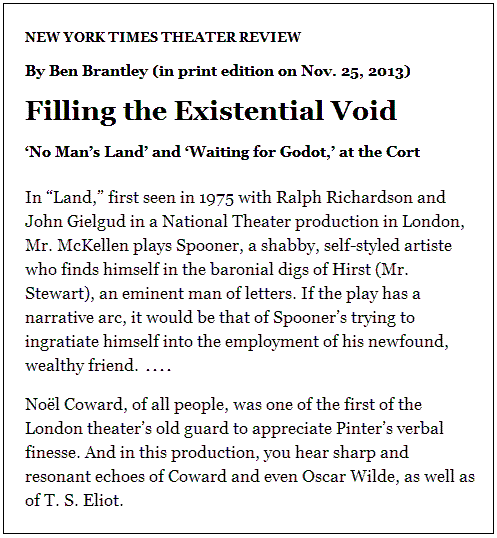
From a slide show of Pinter's "No Man's Land"—

* Footnotes on the title—
For Hirst: Wikipedia.
For Spooner: Into the Woods.
For the groundlings: Urban Dictionary.
Comments Off on Into the Bereshit*
From the New York Times obituary of philanthropist
Fred Kavli, who died on Thursday, November 21—
” In 2005, when Mr. Kavli announced that
he planned to start the prizes, he recalled
skiing in the Norwegian mountains as a boy.
‘At times,’ he told a gathering in New York,
‘the whole sky was aflame with the Northern Lights
shifting and dancing across the sky down to the
white-clad mountaintops. In the stillness and
loneliness of the white mountains, I pondered the
universe, the planet, nature and the wonders of
man. I’m still pondering.’ “
“And we may see the meadow in December, icy white
and crystalline….” — Johnny Mercer, lyrics to Lionel
Hampton and Sonny Burke’s “Midnight Sun”
* Lyche
Comments Off on A Tune for Josefine*
Ben Brantley reviewing a show by the X-Men patriarchs
that opened on Sunday:
"This isn’t just a matter of theatergoers chuckling
to show that they’re smart and cultured and had
damn well better be having a good time after
forking out all that money…."
I prefer reality (which includes the life of Fred Kavli) :

See also Saturday's posts Chess and Frame Tale.
Whether the patriarch Kavli, pictured above, is now having
a good time, I do not know. I hope so.
Comments Off on Windows
A scholium on the link to Pythagoras
in this morning's previous post Figurate Numbers:
For related number mysticism, see Chapter 8, "Magic Numbers,"
in Love and Math: The Heart of Hidden Reality,
by Edward Frenkel (Basic Books, Oct. 1, 2013).
(Click for clearer image.)

See also Frenkel's Metaphors in this journal.
* The wannabe of the title is of course not Langlands, but Frenkel.
Comments Off on Pythagoras Wannabe*
The title refers to a post from July 2012:

The above post, a new description of a class of figurate
numbers that has been studied at least since Pythagoras,
shows that the "triangular numbers" of tradition are not
the only triangular numbers.
"Thus the theory of description matters most.
It is the theory of the word for those
For whom the word is the making of the world…."
— Wallace Stevens, "Description Without Place"
See also Finite Relativity (St. Cecilia's Day, 2012).
Comments Off on Figurate Numbers
Sunday, November 24, 2013
“In 1967, he [Langlands] came up with revolutionary
insights tying together the theory of Galois groups
and another area of mathematics called harmonic
analysis. These two areas, which seem light years
apart, turned out to be closely related.”
— Edward Frenkel, Love and Math, 2013
“Class field theory expresses Galois groups of
abelian extensions of a number field F
in terms of harmonic analysis on the
multiplicative group of [a] locally compact
topological ring, the adèle ring, attached to F.”
— Michael Harris in a description of a Princeton
mathematics department talk of October 2012
Related material: a Saturday evening post.
See also Wikipedia on the history of class field theory.
For greater depth, see Tate’s [1950] thesis and the book
Fourier Analysis on Number Fields .
Comments Off on Galois Groups and Harmonic Analysis
The search for 1984 at the end of last evening’s post
suggests the following Sunday meditation.

My own contribution to this genre—
A triangle-decomposition result from 1984:
The Orwell slogans are false. My own is not.
* The “for Jews” of the title applies to some readers of Edward Frenkel.
Comments Off on Logic for Jews*
Saturday, November 23, 2013
From a recent attempt to vulgarize the Langlands program:
| “Galois’ work is a great example of the power of a mathematical insight….
And then, 150 years later, Langlands took these ideas much farther. In 1967, he came up with revolutionary insights tying together the theory of Galois groups and another area of mathematics called harmonic analysis. These two areas, which seem light years apart, turned out to be closely related.”
— Frenkel, Edward (2013-10-01).
Love and Math: The Heart of Hidden Reality
(p. 78, Basic Books, Kindle Edition)
(Links to related Wikipedia articles have been added.) |
| Wikipedia on the Langlands program
The starting point of the program may be seen as Emil Artin’s reciprocity law [1924-1930], which generalizes quadratic reciprocity. The Artin reciprocity law applies to a Galois extension of algebraic number fields whose Galois group is abelian, assigns L-functions to the one-dimensional representations of this Galois group; and states that these L-functions are identical to certain Dirichlet L-series or more general series (that is, certain analogues of the Riemann zeta function) constructed from Hecke characters. The precise correspondence between these different kinds of L-functions constitutes Artin’s reciprocity law.
For non-abelian Galois groups and higher-dimensional representations of them, one can still define L-functions in a natural way: Artin L-functions.
The insight of Langlands was to find the proper generalization of Dirichlet L-functions, which would allow the formulation of Artin’s statement in this more general setting. |
| From “An Elementary Introduction to the Langlands Program,” by Stephen Gelbart (Bulletin of the American Mathematical Society, New Series , Vol. 10, No. 2, April 1984, pp. 177-219)
On page 194:
“The use of group representations in systematizing and resolving diverse mathematical problems is certainly not new, and the subject has been ably surveyed in several recent articles, notably [ Gross and Mackey ]. The reader is strongly urged to consult these articles, especially for their reformulation of harmonic analysis as a chapter in the theory of group representations.
In harmonic analysis, as well as in the theory of automorphic forms, the fundamental example of a (unitary) representation is the so-called ‘right regular’ representation of G….
Our interest here is in the role representation theory has played in the theory of automorphic forms.* We focus on two separate developments, both of which are eventually synthesized in the Langlands program, and both of which derive from the original contributions of Hecke already described.”
[ Gross ] K. I. Gross, On the evolution of non-commutative harmonic analysis . Amer. Math. Monthly 85 (1978), 525-548.
[ Mackey ] G. Mackey, Harmonic analysis as the exploitation of symmetry—a historical survey . Bull. Amer. Math. Soc. (N.S.) 3 (1980), 543-698.
* A link to a related Math Overflow article has been added. |
In 2011, Frenkel published a commentary in the A.M.S. Bulletin
on Gelbart’s Langlands article. The commentary, written for
a mathematically sophisticated audience, lacks the bold
(and misleading) “light years apart” rhetoric from his new book
quoted above.
In the year the Gelbart article was published, Frenkel was
a senior in high school. The year was 1984.
For some remarks of my own that mention
that year, see a search for 1984 in this journal.
Comments Off on Light Years Apart?
Comments Off on Deo Gratias
“We’ll give the week-end to wisdom, to Weisheit, the rabbi….”
— Wallace Stevens in “Things of August” (see Storyville yesterday)
My choice for a rabbi would be George Steiner.
|
INTERVIEWER
You once referred to the “patience of apprehension” and “open-endedness of asking” which fiction can enact, and yet you have described your fictions as “allegories of argument, stagings of ideas.” Do you still consider them to be “stagings of ideas”?
GEORGE STEINER
Very much so. My writing of fiction comes under a very general heading of those teachers, critics, scholars who like to try their own hand once or twice in their lives.
— The Paris Review, Winter 1995
|
For one such staging, see today’s earlier posts Chess and Frame Tale.
Comments Off on Rabbi
Comments Off on Frame Tale (continued)
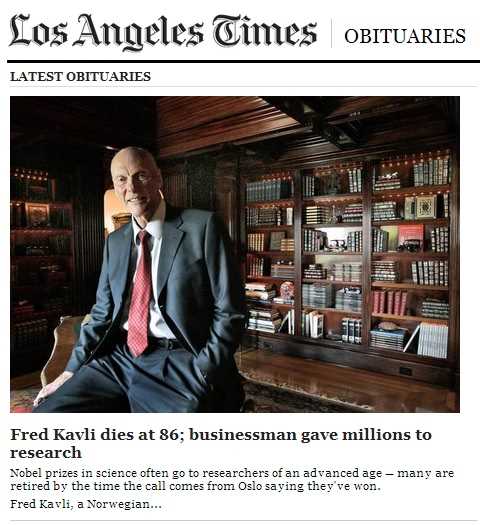
Norwegian, 22, Takes World Chess Title

Quoted here on Thursday, the date of Kavli‘s death:
Herbert Mitgang’s New York Times
obituary of Cleanth Brooks—
“The New Critics advocated close reading of literary texts
and detailed analysis, concentrating on semantics, meter,
imagery, metaphor and symbol as well as references to
history, biography and cultural background.”
See also Steiner, Chess, and Death.
Comments Off on Chess
Friday, November 22, 2013
From a poem in today's previous post:
"Thou art not August unless I make thee so."
This, along with two obituaries in this evening's
online New York Times , suggests the following
passage:
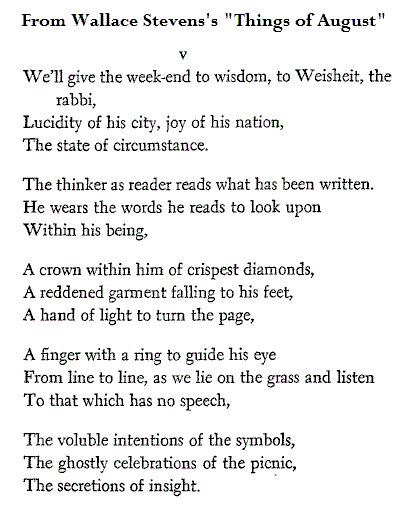
See also Surfaces of a Diamond and Storyville.
Comments Off on Storyville
From David Lavery's weblog today—

It is? Then a check of the rest of the poem seems in order.
In the poem, Stevens speaks of…
The impossible possible philosophers' man,
The man who has had the time to think enough,
The central man, the human globe, responsive
As a mirror with a voice, the man of glass,
Who in a million diamonds sums us up.
Compare and contrast with a rather silly recent music video—

Perhaps Stevens's "human globe" could be portrayed by the
versatile Philip Seymour Hoffman, who stars in a new film directed
by Anton Corbijn, the perpetrator of the above Arcade Fire video.
See also Log24 posts on and just before the video's upload date.
Comments Off on Fiction
Thursday, November 21, 2013
The Mitgang Menu

Related material: This morning's 6 AM post and Wiener News.
Update of 3:29 PM:
From Herbert Mitgang's New York Times
obituary of Cleanth Brooks—
"The New Critics advocated close reading of literary texts
and detailed analysis, concentrating on semantics, meter,
imagery, metaphor and symbol as well as references to
history, biography and cultural background."
Comments Off on ART WARS:
Continued from 24 hours ago.
From this morning's 6 AM (ET) post…
"… you never made a Twelfth Step
call on an active alcoholic by yourself,
unless the alkie in question was safely
incarcerated in a hospital, detox, or the
local bughouse."
— Stephen King, Doctor Sleep
Related material from a math addict, a likely victim
of a professor's misleading rhetoric —
"Frenkel is the real deal, a professor at Berkeley…."
— "Math Porn Update" by David Justice,
Nov. 20, 2013
The rhetoric link above leads to remarks by Frenkel.
For a similar professor's earlier misleading remarks,
see Barry Mazur in this journal.
Comments Off on Twelfth Step
"The shaving razor's cold and it stings."

The above image is from Ulysses “Seen,” adapted
by Robert Berry from the novel by James Joyce.
Comments Off on But It Rings…
Continued from 24 hours ago.
"AA had no rules but many traditions (that were, in fact, rules).
One of the most ironclad was that you never made a Twelfth Step
call on an active alcoholic by yourself, unless the alkie in question
was safely incarcerated in a hospital, detox, or the local bughouse.
If you did, you were apt to end up matching him drink for drink and
line for line."
— King, Stephen (2013-09-24). Doctor Sleep: A Novel
(p. 272). Scribner. Kindle Edition.

" Aus 'It' wurde 'Es', und King sprach es so aus,
dass man sich alleine vom Klang des Titels
gruselte: 'Essssss!' "
— Last night's online
Hamburger Abendblatt
"You want Frye's with that?"
Comments Off on Quad Rants
Wednesday, November 20, 2013
Comments Off on Twelfth Step
(Continued)
This morning's previous post concluded with
a 1938 tune for entertainer Edward Frenkel.
A more up-to-date musical offering:

Comments Off on Blackboard Jungle
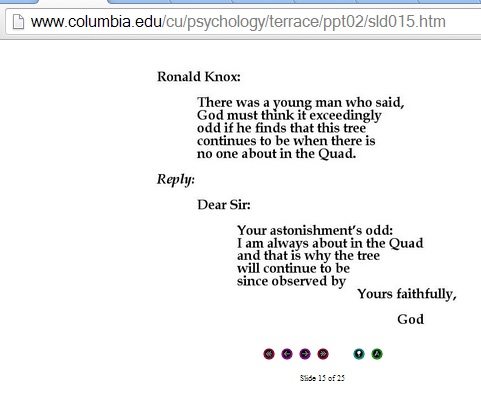


"… the message is clear on what is the main
accomplishment of 19th [century] mathematics:
complex function theory, comprising almost half
the book. The heart and soul of this theory is the
theory of elliptic functions and its generalisations
(abelian functions, elliptic modular functions,
automorphic functions)."
— Viktor Blasjo, Feb. 27, 2006:

Tune for an entertainer —

Comments Off on Quad Rants
Tuesday, November 19, 2013

* Update of 8 PM Nov. 19:
The title refers to a work by Beckett.
"There is nothing outside itself that Quad
might be about." — Sue Wilson.
The Klein group is not so limited.
Comments Off on Quad*
Monday, November 18, 2013
Continued from July 13, 2008.

Happy birthday, Peta Wilson.
Comments Off on Star Quality
"In this book, I will describe one of the biggest ideas
to come out of mathematics in the last fifty years:
the Langlands Program, considered by many as
the Grand Unified Theory of mathematics. It’s a
fascinating theory that weaves a web of tantalizing
connections between mathematical fields that
at first glance seem to be light years apart:
algebra, geometry, number theory, analysis,
and quantum physics. If we think of those fields as
continents in the hidden world of mathematics, then
the Langlands Program is the ultimate teleportation
device, capable of getting us instantly from one of
them to another, and back."
— Edward Frenkel, excerpt from his new book
in today's online New York Times
The four areas of pure mathematics that Frenkel
names do not, of course, seem to be "light years
apart" to those familiar with the development of
mathematics in the nineteenth century.
Related material: Sunday morning's post.
Comments Off on Teleportation Web?
In the spirit of Beckett:
"Bobbies on bicycles two by two…" — Roger Miller, 1965

The Literary Field
A mathematics weblog in Australia today—
Clearly, the full symmetric group contains elements
with no regular cycles, but what about other groups?
Siemons and Zalesskii showed that for any group G
between PSL(n,q) and PGL(n,q) other than for
(n,q)=(2,2) or (2,3), then in any action of G, every
element of G has a regular cycle, except G=PSL(4,2)
acting on 8 points. The exceptions are due to
isomorphisms with the symmetric or alternating groups.
Comments Off on The Four-Gated Song
Comments Off on The Date*
Sunday, November 17, 2013
Continued from November 12, 2013. A post on that date
showed the tree from Waiting for Godot along with the two
X-Men patriarchs. See also last night's Chapel post,
which shows a more interesting tree—

A recent book on the Langlands program by Edward Frenkel
repeats a metaphor about building a bridge between unrelated
worlds within mathematics. A review of the Frenkel book by
Marcus du Sautoy replaces the bridge metaphor with a wormhole .
Some users of such metaphors seem to feel they are justified,
for maximum rhetorical effect, in lying about the unrelatedness of
the worlds being connected. The connections they discuss are
surprising (see the Eichler function discussed by Frenkel and
du Sautoy), but the connections occur, at least in the case of
elliptic curves and modular forms, between areas of mathematics
long known to be, in less subtle ways, related. See remarks
from 2005 by Diamond and Shurman below.
Related material:

Comments Off on The X-Men Tree
Saturday, November 16, 2013
In memory of the translator of Foucault's Pendulum ,
who reportedly died on Tuesday, November 12th—
A detail from an image search (2 MB) linked to here
on that date:

See also Milano in this journal.
Comments Off on Chapel (continued)
"…the source of all great mathematics is the special case,
the concrete example. It is frequent in mathematics that
every instance of a concept of seemingly great generality
is in essence the same as a small and concrete special case."
— Paul Halmos in his autobiography
I Want to Be a Mathematician (1985).
For example:

Comments Off on Example
Jim Holt in the current (Dec. 5) New York Review of Books—
|
One form of Eros is the sexual desire aroused by the physical beauty of a particular beloved person. That, according to Diotima, is the lowest form. With philosophical refinement, however, Eros can be made to ascend toward loftier and loftier objects. The penultimate of these—just short of the Platonic idea of beauty itself—is the perfect and timeless beauty discovered by the mathematical sciences. Such beauty evokes in those able to grasp it a desire to reproduce—not biologically, but intellectually, by begetting additional “gloriously beautiful ideas and theories.” For Diotima, and presumably for Plato as well, the fitting response to mathematical beauty is the form of Eros we call love.
|
Consider (for example) the beauty of the rolling donut—

(Animation source: MIQEL.com)
Comments Off on Mathematics and Rhetoric

Yes. See …
The 48 actions of GL(2,3) on a 3×3 coordinate-array A,
when matrices of that group right-multiply the elements of A,
with A =
(1,1) (1,0) (1,2)
(0,1) (0,0) (0,2)
(2,1) (2,0) (2,2) |
Actions of GL(2,p) on a pxp coordinate-array have the
same sorts of symmetries, where p is any odd prime.
Note that A, regarded in the Sallows manner as a magic square,
has the constant sum (0,0) in rows, columns, both diagonals, and
all four broken diagonals (with arithmetic modulo 3).
For a more sophisticated approach to the structure of the
ninefold square, see Coxeter + Aleph.
Comments Off on Raiders of the Lost Theorem
Friday, November 15, 2013
From a weblog post today—
"one of our great achievements as a species
is the rhetorical question. indeed, this is what
separates us from the higher animals. it is
how we make sense of our lives. our lives
are rhetorical questions, aren't they?"
And our deaths?
Backstory:
This journal on Oct. 25, 2013— St. Crispin's Day—
and a eulogy last night in The New York Times by an
art-department professor, Crispin Sartwell, who is also
the author of the above remarks on rhetorical questions.
Sartwell's Times eulogy was for an older
professor and art theorist, Arthur Danto.
Danto died on Crispin's Day.
Update:

Comments Off on Rhetorical Question
Thursday, November 14, 2013
"Michael Smith… is currently working on a novel
and a three-part history of MI6 entitled:
SIX: A History of Britain's Secret Intelligence Service ."
And then there is…

From a reader review—
"Apparently a classic of the sci-fi cannon…."

Comments Off on Prequel
Wednesday, November 13, 2013

From the obituary of a Bletchley Park
codebreaker who reportedly died on
Armistice Day (Monday, Nov. 11)—
"The main flaw of the Enigma machine,
seen by the inventors as a security-enhancing
measure, was that it would never encipher
a letter as itself…."
Update of 9 PM ET Nov. 13—
"The rogue’s yarn that will run through much of
the material is the algebraic symmetry to which
the name of Galois is attached…."
— Robert P. Langlands,
Institute for Advanced Study, Princeton
"All the turmoil, all the emotions of the scenes
have been digested by the mind into
a grave intellectual whole. It is as though
Bach had written the 1812 Overture."
— Aldous Huxley, "The Best Picture," 1925
Comments Off on X-Code
New York Times theater critic Ben Brantley
last night at 10 PM ET on the opening of a
play by Samuel Beckett —
"The cause of this incontinent mirth?
The dirtiest joke of all time. I mean life itself.
No playwright of the 20th century, and quite
possibly ever, has told this joke with the
clarity, simplicity and richness of Beckett."
Related material — This journal yesterday.
See also Lead Balloon.
Comments Off on Rated X
Tuesday, November 12, 2013

Related material:
The comments on a Log24 post of Nov. 6, 2013,
remarks by Michael Worton on the tree in
"Waiting for Godot," images from the film
"The Tree of Life," and, in memory of Robert
de Marrais, an image search from this evening:
"Spelling the Tree" + "de Marrais," 2 MB.
Comments Off on The X-Men Tree
For and by composer Sir John Tavener, 69,
who reportedly died today.
Update of 8:28 PM ET Nov. 12—
The obituary link above is to The Telegraph.
Here is a link to the version in The New York Times—

Comments Off on Funeral Canticle

“DEVIL – MUSIC
20 pages of incidental music written at school
for G. K. Chesterton’s play MAGIC
by D. Coxeter.”
See also…

Related material — Chesterton + Magic in this journal.
Comments Off on Soundtrack
Monday, November 11, 2013
Or: The Nutshell

What about Pascal?
For some background on Pascal's mathematics,
not his wager, see…
Richmond, H. W.,
"On the Figure of Six Points in Space of Four Dimensions,"
Quarterly Journal of Pure and Applied Mathematics ,
Volume 31 (1900), pp. 125-160,
dated by Richmond March 30,1899
Richmond, H. W.,
"The Figure Formed from Six Points in Space of Four Dimensions,"
Mathematische Annalen ,
Volume 53 (1900), Issue 1-2, pp 161-176,
dated by Richmond February 1, 1899
See also Nocciolo in this journal.
Recall as well that six points in space may,
if constrained to lie on a circle, be given
a religious interpretation. Richmond's
six points are secular and more general.
Comments Off on The Mystic Hexastigm…
The first two pages of a 1989 book by George Steiner—
(Click to enlarge)
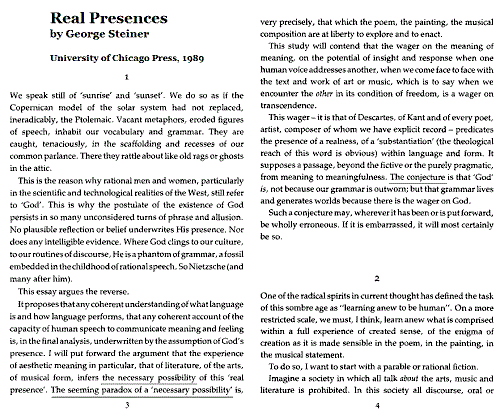
See also yesterday's posts The Field of the Possible
and Abstraction.

Compare and contrast with Socrates in the Meno
quoting Pindar then discussing with a slave boy
the duplication of the square.
Was Socrates a great philosopher or, as the above
figure seems to indicate and as some say of Steiner,
too clever by half ?
Comments Off on Steiner’s Modal Logic
Sunday, November 10, 2013
(Continued from Dec. 6, 2012)

Context:
Chinese Field and Modal Diamond .
(See also today’s previous post.)
Comments Off on Abstraction
This post was suggested by the recent Log24
posts Film Politics, The Wind Rises, and
Figure and Ground, as well as the related
Wikipedia article The Wind Has Risen.

Cover design by Helen Yentus.
Μή, φίλα ψυχά, βίον ἀθάνατον σπεῦδε,
τὰν δ' ἔμπρακτον ἄντλει μαχανάν.
— Pindar, Pythian III , epigraph to
Le Cimetière Marin by Paul Valéry (1920)
O mon âme, n’aspire à la vie immortelle,
mais épuise le champ du possible.
— Pindar, 3e Pythique , epigraph to
The Myth of Sisyphus by Albert Camus (1942)
O my soul, do not aspire to immortal life,
but exhaust the limits of the possible.
— Pindar, Pythian iii , as translated
from the French (or Greek) by Justin O'Brien
in the Knopf Myth of Sisyphus , 1955
Comments Off on The Field of the Possible
Saturday, November 9, 2013
… Or: The Japanese Aesthetics of Zero

Related aesthetic remarks by an author mentioned here
Thursday morning —


Comments Off on Figure and Ground…
"#Haiyan has reached perfection…
8.0 on the Dvorak intensity scale."
Comments Off on The Wind Rises
Comments Off on Film Politics
Friday, November 8, 2013
(Where Entertainment Is God, continued)

Sources: Ctrl Alt Del
Related material: A Log24 post from the release date,
September 10, 2013, for the DVD of "Delete"—
Moss on the Wall.
Comments Off on For Your Viewing Pleasure
Thursday, November 7, 2013
This post was suggested by…
1. Movie reviews links on the NY Times online front page—

2. "When Death tells a story…" in this journal
3. A search for "Recognition" in this journal
(suggested by Terence Cave's Recognitions ,
mentioned in a post of October 31.)
4. The play "Magic," by G. K. Chesterton
5. The following posts —


The post itself consists simply of the title,
together with the above items that suggested
the title.
Comments Off on Recognition
Yesterday afternoon's post linked to efforts by
the late Robert de Marrais to defend a mathematical
approach to structuralism and kaleidoscopic patterns.
Two examples of non-mathematical discourse on
such patterns:
1. A Royal Society paper from 2012—

Click the above image for related material in this journal.
2. A book by Junichi Toyota from 2009—
Kaleidoscopic Grammar: Investigation into the Nature of Binarism
I find such non-mathematical approaches much less interesting
than those based on the mathematics of reflection groups .
De Marrais described the approaches of Vladimir Arnold and,
earlier, of H. S. M. Coxeter, to such groups. These approaches
dealt only with groups of reflections in Euclidean spaces.
My own interest is in groups of reflections in Galois spaces.
See, for instance, A Simple Reflection Group of Order 168.
Galois spaces over fields of characteristic 2 are particularly
relevant to what Toyota calls binarism .
Comments Off on Pattern Grammar
Wednesday, November 6, 2013
The essay excerpted in last night's post on structuralism
is of value as part of a sustained attack by the late
Robert de Marrais on the damned nonsense of the late
French literary theorist Jacques Derrida—
Catastrophes, Kaleidoscopes, String Quartets:
Deploying the Glass Bead Game
Part I: Ministrations Concerning Silliness, or:
Is “Interdisciplinary Thought” an Oxymoron?
Part II: Canonical Collage-oscopes, or:
Claude in Jacques’ Trap? Not What It Sounds Like!
Part III: Grooving on the Sly with Klein Groups
Part IV: Claude’s Kaleidoscope . . . and Carl’s
Part V: Spelling the Tree, from Aleph to Tav
(While Not Forgetting to Shin)
The response of de Marrais to Derrida's oeuvre nicely
exemplifies the maxim of Norman Mailer that
"At times, bullshit can only be countered
with superior bullshit."
Tuesday, November 5, 2013
Comments Off on For St. Robert de Marrais
Continued from 12:03 PM.

See also 12/03 last year.
Comments Off on Culinary Note

Starring Chris Chase as Dr. Caitlin Lightcap…
if you catch my drift.
Only the Dead…
Comments Off on Cut to the Chase
Comments Off on Talk Amongst Yourselves

Suggested by a story in today's Harvard Crimson —
"You want Frye's with that?"
Comments Off on Culinary Note
Monday, November 4, 2013

The Flickr source of the above hashtags photo,
titled "Lots of Hash" —

See also this journal on the date the photo was taken.
#Source
Comments Off on Hashtags for Dinner
Sunday, November 3, 2013
From a book by Harvard mathematician Barry Mazur —

"Part of the self leaves the body when we sleep…"
The video —

See also the Saturday evening post "Fingo."
Comments Off on YouTube Music Award
"And behold, a white horse." — Johnny Cash
See also references to such a horse here.
Comments Off on Sermon
The title, that of a novel by Arthur Koestler,
has appeared before in this journal.
The title was quoted in a Log24 note of
May 29, 2002 (G.K. Chesterton's birthday).
The link in Saturday evening's post to a Chesterton
essay suggested a further search that yielded
the following quotation—
Then silence sank. And slowly
Arose the sea-land lord
Like some vast beast for mystery,
He filled the room and porch and sky,
And from a cobwebbed nail on high
Unhooked his heavy sword.
— G. K. Chesterton,
The Ballad of the White Horse
This, together with some Log24 remarks
from 2004, suggests two images—
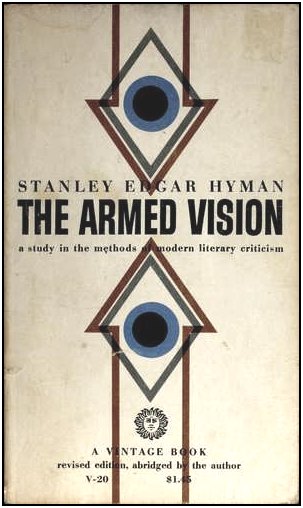
Above: A 1955 cover design by Robert Flynn.
The arrow theme also appears in a figure from
John Sealander's Road to Nowhere in the 2004
remarks:

The remarks quoting the Sealander image, from
March 5, 2004, were on mathematics and narrative.
Related material from a year later:
See an announcement, saved from March 16, 2005,
of a conference on mathematics and narrative that
was held in July 2005. Some context: Koestler's novel.
Comments Off on The Call Girls
Saturday, November 2, 2013
The title, derived from a saying of Newton,
might apply to an essay by David Justice
that contains the following passage—
|
Our proposals are in the spirit of
Chesterton’s essay “The Diabolist”
(in Tremendous Trifles ), p. 101:
“Aren’t those sparks splendid?” I said.
“Yes,” he replied.
“That is all that I ask you to admit,”
said I. “Give me those few red specks,
and I will deduce Christian morality."
[Link added to Justice’s original.]
|
Some context:
Sparks Middle School and the film "Insidious"—

Comments Off on Fingo
See All Souls in this journal.
Comments Off on Review
Friday, November 1, 2013
In "Notes on Finite Group Theory"
by Peter J. Cameron (October 2013),
http://www.maths.qmul.ac.uk/~pjc/notes/gt.pdf,
some parts are particularly related to the mathematics of
the 4×4 square (viewable in various ways as four quartets)—
-
Definition 1.3.1, Group actions, and example on partitions of a 4-set, p. 19.
-
Exercise 1.1, The group of Fano-plane symmetries, p. 35.
-
Exercise 2.17, The group of the empty set and the 15 two-subsets of a six-set, p. 66.
-
Section 3.1.2, The holomorph of a group, p. 70.
-
Exercise 3.7, The groups A8 and AGL(4,2), p. 78.
Cameron is the author of Parallelisms of Complete Designs ,
a book notable in part for its chapter epigraphs from T.S. Eliot's
Four Quartets . These epigraphs, if not the text proper, seem
appropriate for All Saints' Day.
But note also Log24 posts tagged Not Theology.
Comments Off on Cameron’s Group Theory Notes
See the title phrase in this journal.
See also posts from last August tagged Storyville.
Comments Off on Colorful Tale
See Josh Lederman's AP story on this year's
colorful White House Halloween decorations.
Orange and black are also the Princeton colors.
See as well The Crosswicks Curse.
Comments Off on Orange and Black at the White House















































































